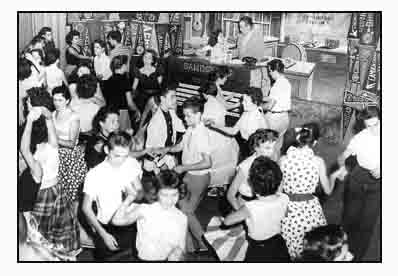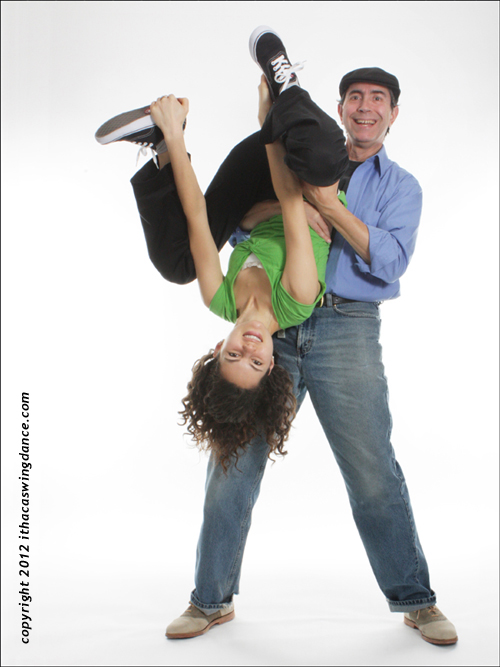

|
'50s
JITTERBUG aka
Rock 'n' Roll : History
kurt lichtmann In the '30s and '40s, you went to Harlem's Savoy Ballroom for the ultimate source of swing era dance style. In the '50s, you went to your living room! On any school day, you could return home and dig the 3pm broadcast on ABC-TV of WFIL Philadelphia's nationally syndicated AMERICAN BANDSTAND. |
 The
Bandstand dancers themselves simply called it FAST DANCING* (NOT Jitterbug,
NOT Lindy). But in the NYC-NJ area, some (especially those of the previous generation)
called it LINDY or JITTERBUG. Some called it ROCK 'N' ROLL**.
Most bandstanders learned the dance from their peers on this TV show. Whereas
the top dancers of the Savoy were stage and screen pros of enormous dedication
and attainment, Bandstanders were not chosen for dance ability: they just showed
up. The teens came to the TV studio mainly from two local high schools: West
Catholic and South Philadelphia.
The
Bandstand dancers themselves simply called it FAST DANCING* (NOT Jitterbug,
NOT Lindy). But in the NYC-NJ area, some (especially those of the previous generation)
called it LINDY or JITTERBUG. Some called it ROCK 'N' ROLL**.
Most bandstanders learned the dance from their peers on this TV show. Whereas
the top dancers of the Savoy were stage and screen pros of enormous dedication
and attainment, Bandstanders were not chosen for dance ability: they just showed
up. The teens came to the TV studio mainly from two local high schools: West
Catholic and South Philadelphia.
In order to conform to the carefully crafted Bandstand image, Dick Clark, the show's gifted producer and host, did not permit aerials, lifts, dips, partnered charlestons, or jazz moves. Also, the tight confines of the studio's hard concrete floor, obstructed by bulky moving TV cameras, and criss-crossed with thick video cables, was hardly condusive to any kind of flash dancing. The kids tended naturally to dance in small slots. Even the rare really good dancers that came to Bandstand could only display a small fraction of their chops. But since the Bandstand dancers were the primary dance models for '50s America teens, you can understand how the vast repertoire of early Lindy Hop (on the TV, at least) now achieved its ultimate simplification for mass consumption.
Numerous teen viewers added their own playful genius to the TV basics, developing entirely new repertoires of moves. After all, rock'n'roll has a distinct feel; one would expect new moves and stylings. In the Carolinas, for example, huge groups of '50s teens had independently taken a dance they called JITTERBUG (unique in style, and eventually re-named CAROLINA SHAG) to incredible heights of sophistication. That didn't happen on Bandstand in the '50s. Since Dick Clark did not allow his regulars to perform professionally, they received little encouragement to develop as dancers. In fact, according to our nterviews with old-timers, many of the best regulars NEVER practiced on their own.
But, this isn't the whole story. Watch the flicks Don't Knock The Rock
and Rock Around The Clock. In addition to smokin' performances
by Bill Haley's Comets, you will see Dean Collins' style LINDY HOP
adapted to '50s rock&roll by some hot young professional dancers. It adapts
pretty darn well, in fact! Given the usual imitative bent of talented amateur
dancers, we can expect that 15-20 viewings of these movies gave hometown teens
what they needed to continue Hollywood-style Lindy, going far beyond what American
Bandstand offered them.
** As a relevant aside, the term "ROCK & ROLL" was appropriated
by Alan Freed for this 50s music style.
He is famous for that. But he did not invent to the term! It was in use
well back into the 1920s, and can be heard in song lyrics by the Boswell Sisters,
Ella Fitzgerald with Chick Webb, and Cab Calloway!
Where did the Bandstanders themselves learn this style of dance?
yeah, where?
*** This comes from Charles Amann, an author
who often danced with some of the well-known Bandstand regulars at dances
in Leheigh Valley PA. He is currently completing a book on American Bandstand's
Philadelphia years.
Photo: WFIL-TV Philly (pre-Dick Clark) "AMERICAN BANDSTAND"
John A. Jackson, Oxford U. Press 1997

Swing Dance, 50s style - the author with Liz Welch